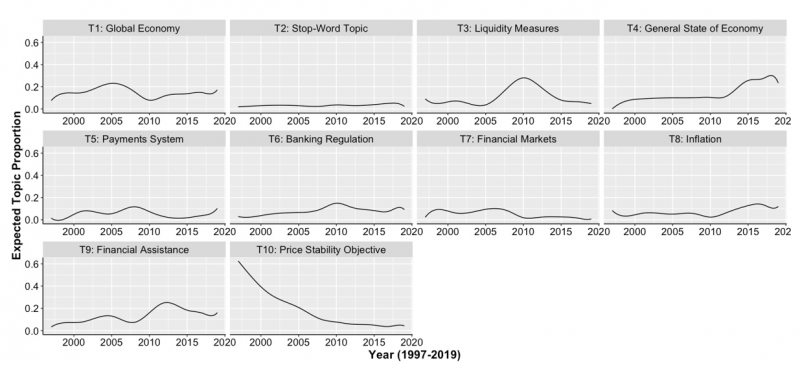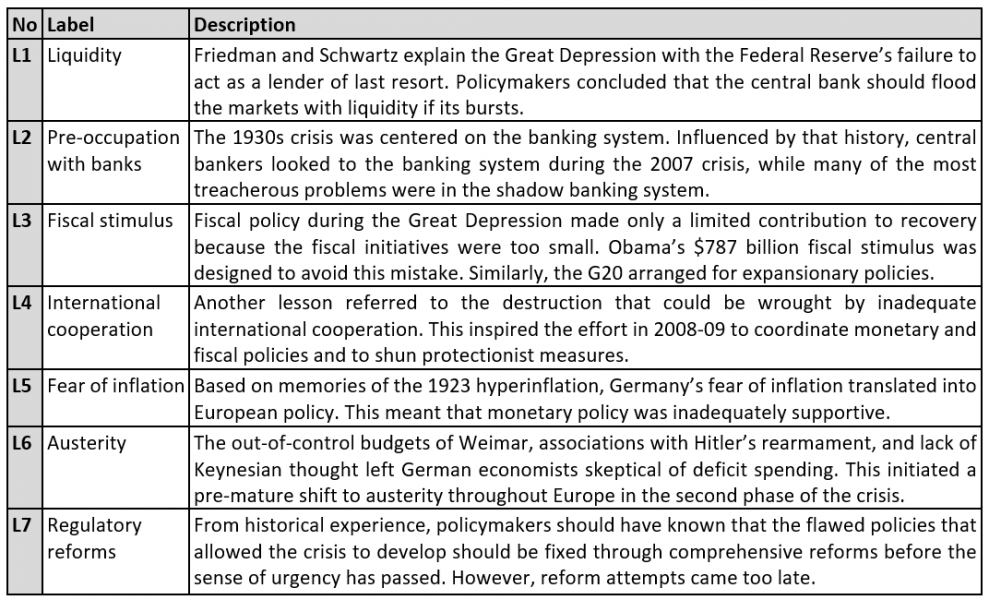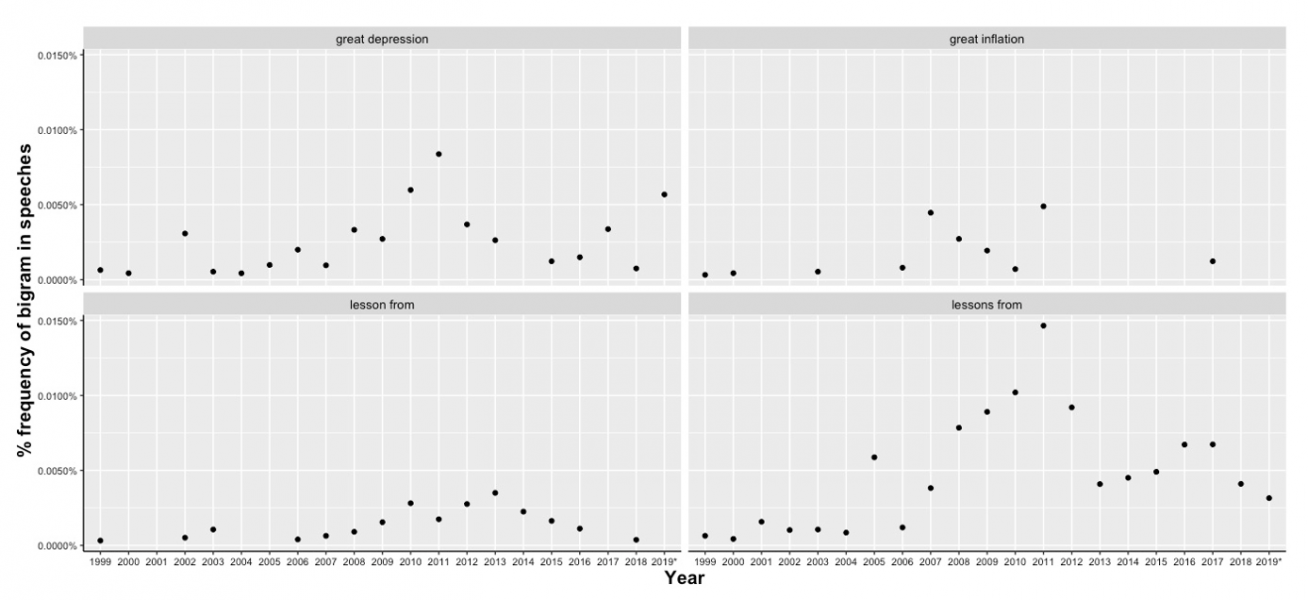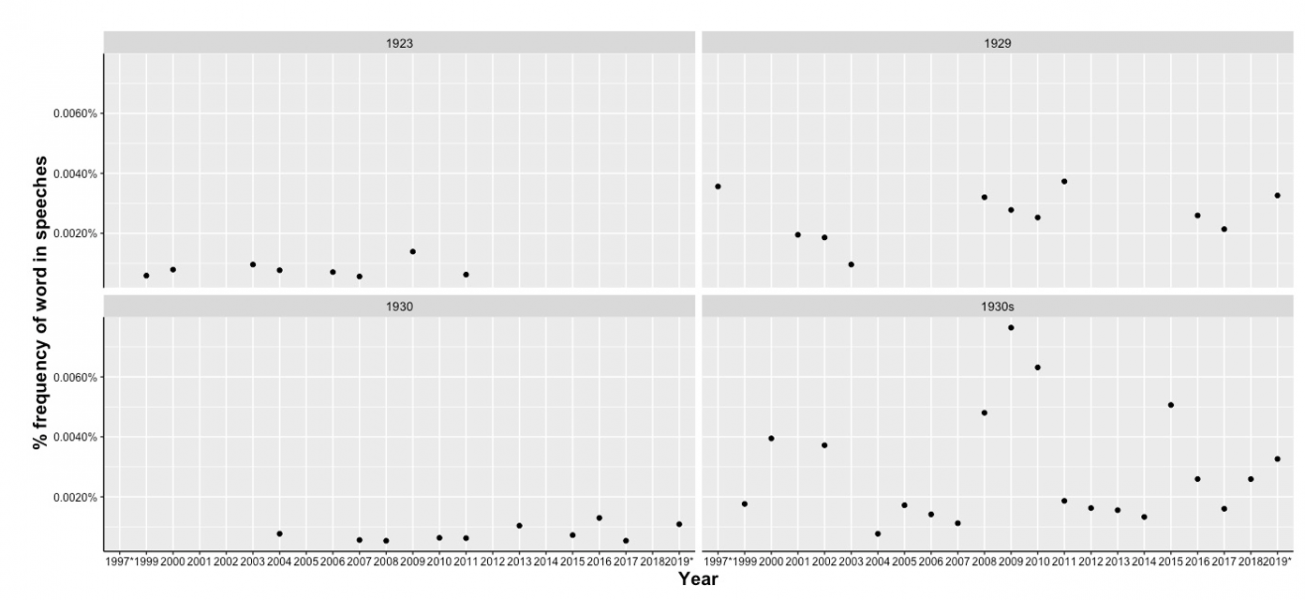

By employing Text Mining methods such as Structural Topic Modeling to examine all 2,135 speeches by ECB Executive Board members between February 1997 and October 2019, it is possible to identify a significant semantic change that occurred in ECB communication in the transition from Great Moderation to Great Recession. The methodology allows for a structured and empirical assessment of the hypothesis that central bankers used ‘lessons from the past’ during the financial crisis. The quantitative and qualitative results indicate that references to historical analogies increased at the height of the crisis (2009-11) but often served only rhetorical functions.
Following the outbreak of the global financial crisis in 2007, numerous observers used references to the Great Depression and the lessons that might be learned. In his influential monograph, Eichengreen (2015) argues that during this crisis period, a repeat of the 1930s was avoided because central bankers and politicians recognized the Great Depression’s lessons regarding monetary and fiscal policy. To test this proposition, I examine all 2,135 speeches by ECB Executive Board members between February 1997 and October 2019 (Küsters 2022). The occurrence of historical analogies can be examined by estimating a Structural Topic Model, frequency plots of key bigrams and dates, and manual classification of speeches. The results indicate that references to historical analogies increased at the height of the crisis but often served only rhetorical functions.
A corpus with speeches of ECB Executive Board members can be downloaded from the ECB website and contained, at the time of writing, all speeches until October 11, 2019, together with limited metadata. After some slight manual changes, the resulting database consists of 2,135 speeches or 3,114,853 words. While one needs to keep in mind that the central bank’s communication strategy strongly shapes these speeches, it is essential to know whether this strategy presents the past as a foundation of central bankers’ decisions and, if so, how it discriminates among different historical experiences of member states. Exploratory analysis of the ECB corpus via descriptive statistics and Text Mining methods suggests a decisive break: Following the outbreak of the Great Recession, the number of ECB speeches increased significantly, their net sentiment dropped from a generally positive to a negative tone, and their semantic content changed considerably (as measured by word correlations and td-idf scores). Still, more subtle methods are required to assess the claim that lessons from the past drive this change in communication.
To begin with, I estimate a specific type of probabilistic Topic Model known as Structural Topic Model (STM). Generally, Topic Models are algorithms for discovering the main themes that pervade an extensive collection of texts (Blei 2012). Without any prior categorization, topics emerge from the analysis of semantic data as captured in speeches and the model then organizes the corpus according to the discovered themes. These models are generative models of word counts, with a topic being defined as a mixture of words, with each word having a probability of belonging to a topic. Researchers look at the words associated with each topic and manually attach a meaningful label to interpret the computational output. The key innovation of STM is that it incorporates document-related information into the topic estimation stage. In the case of the ECB corpus, metadata corresponds to the speaker’s name and the year in which the speech was given.
Figure 1: Graphical display of topic prevalence

Note: Each topic’s prevalence is plotted as a smooth function of year, holding speaker’s influence at sample median, without confidence intervals. Source: 10-topic STM, see Küsters (2022).
In addition to capturing the main content of ECB speeches over more than twenty years, the STM output allows investigating the temporal dimension of these topics by plotting topic prevalence as a function of year (Figure 1). The ten topics mirror the evolution of the Great Recession quite remarkably. The presence of inflation concerns (T8), the ongoing focus on payments integration (T5), and the simultaneous disinterest in any types of liquidity measures (T3) before and throughout the 2007 speeches reflect the then prevailing narrative of Great Moderation. Following the Lehman bankruptcy in 2008, the shares of speeches discussing liquidity measures (T3) or banking reforms (T6) began to rise only gradually. Ultimately, speeches describing the ECB’s fiscal assistance (T9) to states in financial difficulty peaked in 2012, when Greece received a second bailout package and the ESM was established as a permanent firewall for the Eurozone. Remarkably, inflation fear (T8) and insistence on price stability as primary objective (T10) formed an integral part of ECB speeches even in the most dramatic moments. Still, their trajectories differ significantly: While T10 is steadily declining and cannot reach pre-crisis levels for the entire duration of the Great Recession, inflation concerns (T8) intuitively bottomed out in the depths of the crisis but recovered quickly thereafter, reaching an all-time high after 2015. Accompanied by relatively late proposals for banking regulation (T6) that only peaked in 2010, these topics also formed the intellectual background for the bailout negotiations during the acute phase of the Eurozone crisis.
Since the optimal extent of central banks’ accommodating monetary policy during the Great Recession is controversially discussed until this day, it is instructive to compare the development of the liquidity measures topic (T3) with the topic describing the ECB’s concerns regarding inflation (T8). Interestingly, the share of speeches discussing liquidity measures, including OMTs, peaked in 2010, two years before Draghi’s well-known ‘whatever it takes’ remarks. At the same time, inflations concerns (T8) were at their all-time low. From 2010, however, the share of speeches discussing the inflation topic increased.
A careful close reading of Eichengreen (2015) enables the reader to identify seven distinctive lessons from the past that can be grouped around two phases of the crisis: lessons that inspired the immediate monetary and fiscal reactions when the crisis erupted and spread from the US to Europe (2007–2009); and lessons that shaped the later handling of the sovereign debt crisis in Europe (2010–2015). One can compare Eichengreen’s historical lessons with the topics estimated by the STM (Table 1). In cases where one (or several) historical lessons are represented by an estimated topic, one receives an upper-bound estimate for the prevalence of the respective lesson in the ECB’s communication.
Table 1: Summary of Eichengreen’s lessons from the past that influenced policymakers during the Great Recession

European central bankers’ sensitivity to inflation (L5) is captured by the continued presence of the inflation topic (T8), accompanied by the topic describing the price stability objective (T10), even in the most dramatic months. To a certain extent, this simply reflects the fact that price stability is the explicit mandate of the ECB, so one would naturally expect that it is always mentioned in ECB speeches. Particularly from 2012 onwards, however, discussions about inflation (T8) assumed ever-larger proportions in ECB speeches, supporting Eichengreen’s (2015: 304) notion that the ‘mandate to pursue low inflation […] continued to guide and constrain policy.’ According to Eichengreen (2015: 284), the analogy with the Great Depression ‘was foremost in the minds of policy makers’ during ’a brief period in 2008-09,’ but subsequently, ‘the emphasis shifted’ towards balanced budgets. His timing of this pre-mature shift to austerity (L6) is confirmed by the STM, which records a steady increase of discussions about competitiveness, productivity, and structural reforms (T1) from 2010 onwards.
Similarly, the central banks’ ‘readiness to provide not just liquidity but unlimited amounts of liquidity (Eichengreen: 2015: 176f.) that was informed by economic history (L1) is mirrored by the liquidity topic (T3), which rises rapidly between 2007-09 and peaks in 2010. After that, T3 declines in line with the ECB’s first ‘phasing-out.’ The extent to which liquidity measures were discussed in ECB speeches continued to decline in later years. This is again in line with Eichengreen’s argument that in the European context, the analogy with the Great Depression was particularly influential in the first years of the crisis, but not afterwards. This is further supported by the trajectory of T9, which fits well with the argument for fiscal stimulus (L3) but reaches a low point in 2008 and only increases after the peak of the crisis, probably in tandem with the Greek bailout packages.
Eichengreen (2015: 381) also notes that central banks’ policies were targeted at banks (L2) due to a ‘historically informed vision of the risks’ and given T6’s continued presence, this pre-occupation with banks is visible in ECB speeches. However, given that the shadow banking system is significantly smaller and less relevant in Europe than in the US, this historical lesson of focusing on the banking system suits well the structural characteristics of the European financial system. Additionally, the evolution of T6, which contains proposals for banking reforms, supports Eichengreen’s notion that banking reforms were initiated too late (L7), as T6’s proportion is substantial from 2010 onwards but rather small when the financial crisis spread from the US to Europe and there was a sense of urgency.
A more direct approach to identifying lessons from the past is to search the corpus for crucial terms such as ‘history,’ ‘lessons,’ or ‘past.’ However, manual search quickly clarifies that these multifunctional words are often unrelated to actual lessons from the past. When tracing the Great Depression analogy, it makes more sense to examine pairs of two consecutive words, called ‘bigrams’ (Figure 2). The resulting diagrams underline that there was indeed a sharp increase in references to the ‘Great Depression’ in 2010 and 2011, and more generally to ‘lesson(s) from’ the past. As a comparison, references to the ‘Great Inflation’ in the wake of the 1970s oil price shocks occurred less frequently, but even here one detects an increase in references at the height of the Great Recession. Taken together, in all four panels of the figure, a substantial increase in relative bigram frequencies can be seen during the Great Recession.
Figure 2: Relative frequency of key bigrams related to lessons from the past

Source: ECB corpus, see Küsters (2022).
In addition to bigrams, specific dates might be a precise proxy for tracing historical lessons (Figure 3). In line with the trajectory of key bigrams, Board members referred increasingly to ‘1929’ and ‘1930s’ during the Great Recession, with a potential peak between 2009-11. Such bell-shaped patterns are typical phenomena in the field of Narrative Economics (Shiller 2017). This implies that the narrative recourse to historical lessons during a crisis follows the typical innovation cycle of adoption, peak, and decline. By contrast, recourses to the ‘1923’ hyperinflation were less frequent and did not occur once the crisis dispersed, whereas references to ‘1930’ as a single year increased only lately.
Figure 3: Relative frequency of key dates related to lessons from the interwar period (hyperinflation and Great Depression)

Source: ECB corpus, see Küsters (2022).
Turning from the quantitative to the qualitative, the question is which specific lessons were utilized during this time of crisis. To get an impression of this, a subset of the corpus covering all ECB speeches during the Great Recession (2007-2015) is searched for references to the German hyperinflation (‘hyperinflation,’ ‘1923’) and the dates commonly associated with the Great Depression (‘1929,’ ‘1930,’ ‘1930s’). Within this subset, these five search terms can be found in 90 speeches (8.92%). The comparatively smaller number of speeches allows for detailed close reading, based on which each speech can be manually classified according to the specific historical lesson evoked by the speaker. It is determined if the speaker used the respective term only in a loose, comparative way (like ‘the deepest crisis since the beginning of the Great Depression in 1929’) or if she or he outlined one of the historical lessons (L1-7) in more detail.
Table 2: Tracing lessons from the past in ECB speeches between 2007-15

Source: Küsters (2022).
Three findings emerge from this exercise (Table 2). First, almost half of the identified references are only rhetorical means unrelated to the usage of actual historical lessons, shrinking the latter’s proportion in the subset of speeches to roughly 5% (overall corpus: 2.34%). Secondly, one can identify a division of labor concerning how specific historical experiences are remembered. The German experience of a ‘hyperinflation’ in ‘1923’ is typically mentioned when the speaker emphasizes the economic and social importance of rigorous price stability, while ‘1929’ immediately leads to associations of insufficient liquidity. By contrast, references to the ‘1930s’ period, in general, can form the background to various, even conflicting, lessons, but their most frequent purpose is to illustrate the need for cooperation. Thirdly, if one understands Eichengreen’s seven lessons as a pool of lessons readily available when a speaker decides on the speech’s content, the aggregate ranking of lessons as actually used reveals the Board members’ preferences. Price stability, cooperation, and liquidity seem to have been their main priorities, and the respective lessons invoked in their favor recall Eichengreen’s narrative.
To sum up, it is possible to find empirical evidence for some of Eichengreen’s (2015) lessons that go beyond the occasional anecdote à la Bernanke. Frequency analysis of key bigrams and dates related to the Great Depression confirm that there was indeed an increase in historical analogies, particularly between 2009-11. Interestingly, ECB speeches kept referring to inflation throughout the Great Recession, while liquidity measures were only discussed briefly. The temporal dimension of this evidence, as measured by the STM, confirms a shift in policy priorities from 2010 onwards. However, the speeches that described these historical lessons in more detail, instead of merely including comparisons with the Great Depression as a rhetorical device, constituted only 5% of all speeches given between 2007-15. These findings raise the question to which extent complex and often ambiguous references to ‘lessons from the past’ constitute, in a technical sense, ‘noise’ in central bank communication that ultimately reduces the latter’s predictability, effectiveness, and general accessibility (Haldane and McMahon 2018).
Blei, D. 2012. “Probabilistic Topic Models.” Communications of the ACM 55 (4): 77–84.
Eichengreen, B. 2015. Hall of Mirrors: The Great Depression, the Great Recession, and the Uses – and Misuses – of History. New York: Oxford University Press.
Haldane, A. and M. McMahon. 2018. “Central Bank Communications and the General Public.” AEA Papers and Proceedings 108 (May): 578–83.
Küsters, A. 2022. “Applying Lessons from the Past? Exploring Historical Analogies in ECB Speeches through Text Mining, 1997-2019.” International Journal of Central Banking 18 (1): 27 –329.
Shiller, R. 2017. “Narrative Economics.” The American Economic Review 107 (4): 967–1004.